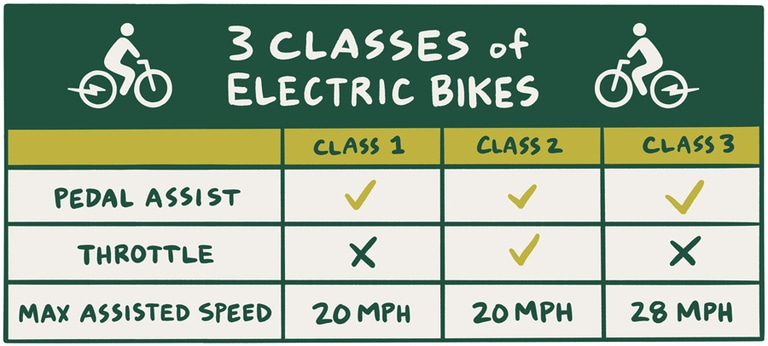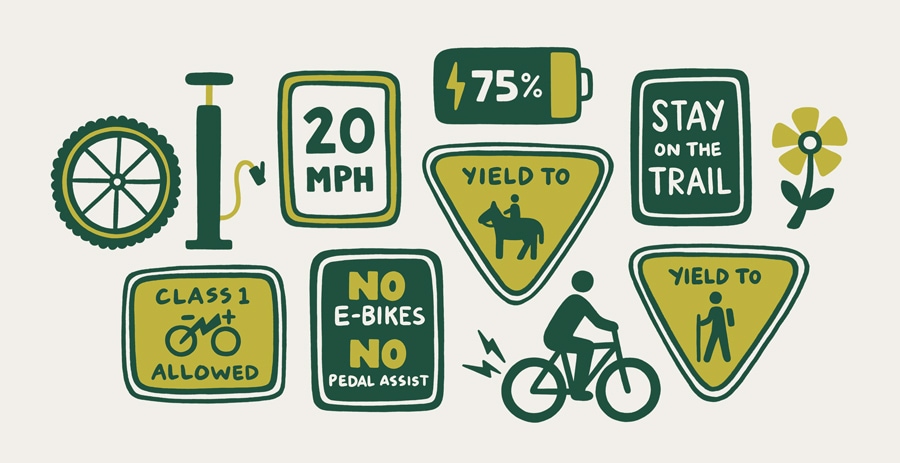Most mountain biking takes place on trails that are shared with hikers, equestrians and other outdoor enthusiasts. Since 1988, the International Mountain Bicycling Association (IMBA) has offered the Rules of the Trail to promote responsible and courteous conduct on shared-use trails and to help everyone have enjoyable experiences.
Think of these rules as a mountain biker's addendum to the Leave No Trace principles for all outdoor users. By embracing these simple guidelines you can be sure that you're doing your part to respect both the natural world and your fellow trail users.
While the rules and etiquette for electric mountain bikes are mostly the same as for non-electric riding, there are some important points to consider so that everyone on the trail has fun. We'll first cover general guidelines and then a few specific to e-mountain biking.
Electric only? Jump ahead to read about Mountain Biking Etiquette for e-MTBs.
Rules of the Trail for Mountain Biking
- Ride open trails.
- Leave No Trace.
- Control your bicycle.
- Yield appropriately.
- Never scare animals.
- Plan ahead.
In the past, riders who played by the rules opened up the places we all love today. With so many open trails available, there's no reason not to find one.
- Respect trail and road closures—if you're unsure, ask a land manager.
- Don't trespass on private land—get a permit or other required authorization.
- Never ride in areas protected as state or federal wilderness—it's against the law.
The primal appeal of mud doesn't justify a splatterfest that damages the underlying trailbed.
- Muddy trails are vulnerable to damage — consider other options if a trail is soft.
- Stay on existing trails — never create a new one.
- Don't cut switchbacks.
- Pack out at least as much as you pack in.
Keep your head up and your adrenaline in check. When you see videos of riders seeming to defy the laws of physics, use them as inspiration to develop your skills.
- Obey all speed regulations and recommendations.
- Stay alert — inattention for even a moment can put yourself and others at risk.
- Always ride within your limits.
Learn the rules below as well as the local rules, because conventions for yielding and passing may vary in different locations, or with traffic conditions. You want every encounter to be a happy one.
- Always let other trail users know you're coming — give a friendly greeting.
- Anticipate other trail users as you ride around corners.
- Yield to non-bike trail users (gently enlighten them if the trail is clearly signed for bike-only travel).
- Yield to riders headed uphill whenever you're riding downhill (gently enlighten them if the trail is clearly signed for one-way or downhill-only traffic).
- Make every pass a safe and courteous one.
A frightened animal can be both vulnerable and dangerous. The only thing that keeps animals safe from you is you.
- Stay alert — animals are easily startled by an unannounced approach, a sudden movement or a loud noise.
- Give animals enough room and time to adjust to you.
- Use special care when passing horses — follow directions from the horseback riders (ask if uncertain).
- Never disturb wildlife, cattle or other domestic animals.
Learning the IMBA Rules of the Trail is a good first step. You should also research your trip and pack wisely — preparing well is always easier than triage on the trail.
Many trail systems use trail signs with the same symbols that ski areas rely on to mark difficulty: green circles for beginner-friendly trails, blue squares for trails suited to intermediate riders, and black (or, gulp, double black) diamonds for expert-only options.
Additional tips:
- Know your equipment, your ability and how to properly prepare for the area where you're riding.
- Be self-sufficient — keep your equipment in good repair and carry supplies for changes in weather and other conditions.
- Always wear a helmet and appropriate safety gear.
As e-mountain bikes surge in popularity and attract new people to the sport, trail etiquette—knowing how to respectfully and safely share trails with human-powered bikes, hikers and horses—is critical. After all, land managers are still deciding where and whether to permit e-MTBs, or not. "This is a new group of riders in the mountain bike world," says Roland Czuday, product manager for e-bikes at Cannondale.
There's good news for those of us who already have some experience mountain biking: Much of the etiquette for these new bikes remains the same, says Rachel Fussell, eMTB Policy & Program Manager at PeopleForBikes. "There are only a few things you need to think about as an e-bike user that might be slightly different," says Fussell.
Here's what to keep top of mind as you saddle up on your electric steed:
Know where you're allowed to ride.
This is arguably the most important piece of e- bike etiquette. Flouting rules put in place by governments or private landowners could lead to crackdowns on bicycle use—e-bikes and non-electric bikes alike. So, before you ride, do your homework: Check with local land management agencies, Facebook groups and bike shops to suss out where you can, and can't, ride your electric mountain bike. Apps like Trailforks and Mountain Bike Project and resources like Trails are Common Ground and IMBA often spell out whether a particular trail or section of trail is open to e-bikes. When in doubt, Fussell says, "I would always err on the side of caution."

Know the class of your e-MTB.
There are currently three classes of e-bikes. Class 1 refers to pedal-assisted bikes that can travel at speeds of up to 20 miles per hour. When you stop pedaling a Class 1 bike, the bike doesn't keep propelling itself. A Class 2 bike has a pedal assist and a throttle so that the bike can keep moving even when you don't pedal; pedal assist stops at 20 mph. Class 3 has no throttle; pedal assist stops once you reach a speed of 28 mph. You should sort out what kind of bike you'll be riding before you buy it.
Yield to everyone.
On a non-electric bike, the etiquette is simple: Let both horses and hikers have the right of way; downhill riders yield to uphill riders (which we covered above). Here's the difference: On an electric bike, experts say it's best practice to be prepared to yield to everyone, even when you're going uphill. The logic: E-bikes are still new to trails and still building the kind of goodwill that can lead to better access down the road. Plus, it's not hard to start up again when you've got a battery doing some of the work. "The stronger participant should yield to the one that's weaker," Czuday says. Like it or not, when you ride that e-bike, you're an ambassador for this new technology. Send the right message, he says.
Watch your speed.
When it comes to a tough climb, these e-bikes are certainly capable of blowing past anyone without a motor. "You can be easily two to three times faster on the uphills," Czuday says. That's fine (climbing with ease is the point!). At the same time, nobody wants to be huffing up a punishing ascent, only to have a powered bike charge up behind him like some jerk on the freeway. If you approach another rider from behind, whatever the direction, just say "hey" in a friendly way and wait for them to find a good spot to pull over and let you breeze past.
Keep an eye on battery life.
Batteries drain. The last thing you want while e-biking is to run out of juice halfway through a long ride, especially if weather conditions or your fitness level might make it difficult or dangerous to slog back to the trailhead. An e-bike isn't a license to abandon the best tool of all: your common sense.
Be extra prepared for hazards.
Because e-bikes are heavier and can travel faster, flat tires are more likely. And because these bikes can travel farther from aid or a trailhead, having extra tubes, and the know-how to fix a flat, are essential. (See: Sense, Common, above.)
Respect the land.
While various studies have shown that e-bikes don't hurt trails more than traditional mountain bikes, they do tend to be heavier, thanks to that battery. It's extra important to avoid actions that could damage the landscape, like trail braiding; riding when it's muddy outside; or stepping on sensitive plants.
Why do these guidelines matter? "First and foremost, it's about safety," says Dave Wiens, executive director of the International Mountain Biking Association. "The second is protecting access for bikes. There's always an opportunity for conflict, and potentially losing access for all mountain bikes." Riders need to keep the good vibes flowing — and that's a responsibility of every rider, says Wiens. "The pendulum is swinging towards acceptance," he says. I know several folks who were against e-bikes, and now you can't get them off of them."
